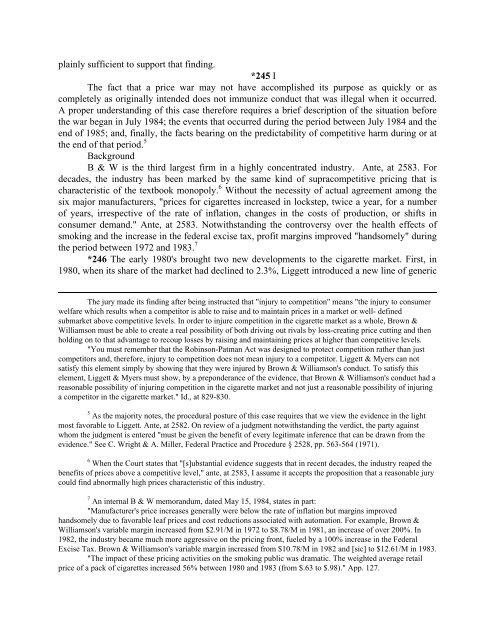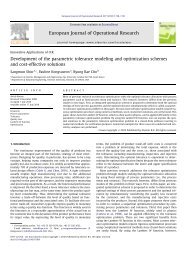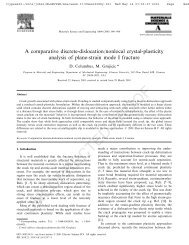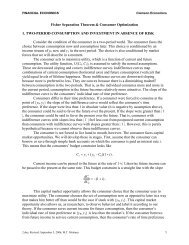509 U.S. 209, 113 S.Ct. 2578 BROOKE GROUP LTD., Petitioner v ...
509 U.S. 209, 113 S.Ct. 2578 BROOKE GROUP LTD., Petitioner v ...
509 U.S. 209, 113 S.Ct. 2578 BROOKE GROUP LTD., Petitioner v ...
Create successful ePaper yourself
Turn your PDF publications into a flip-book with our unique Google optimized e-Paper software.
plainly sufficient to support that finding.<br />
*245 I<br />
The fact that a price war may not have accomplished its purpose as quickly or as<br />
completely as originally intended does not immunize conduct that was illegal when it occurred.<br />
A proper understanding of this case therefore requires a brief description of the situation before<br />
the war began in July 1984; the events that occurred during the period between July 1984 and the<br />
end of 1985; and, finally, the facts bearing on the predictability of competitive harm during or at<br />
the end of that period. 5<br />
Background<br />
B & W is the third largest firm in a highly concentrated industry. Ante, at 2583. For<br />
decades, the industry has been marked by the same kind of supracompetitive pricing that is<br />
characteristic of the textbook monopoly. 6 Without the necessity of actual agreement among the<br />
six major manufacturers, "prices for cigarettes increased in lockstep, twice a year, for a number<br />
of years, irrespective of the rate of inflation, changes in the costs of production, or shifts in<br />
consumer demand." Ante, at 2583. Notwithstanding the controversy over the health effects of<br />
smoking and the increase in the federal excise tax, profit margins improved "handsomely" during<br />
the period between 1972 and 1983. 7<br />
*246 The early 1980's brought two new developments to the cigarette market. First, in<br />
1980, when its share of the market had declined to 2.3%, Liggett introduced a new line of generic<br />
The jury made its finding after being instructed that "injury to competition" means "the injury to consumer<br />
welfare which results when a competitor is able to raise and to maintain prices in a market or well- defined<br />
submarket above competitive levels. In order to injure competition in the cigarette market as a whole, Brown &<br />
Williamson must be able to create a real possibility of both driving out rivals by loss-creating price cutting and then<br />
holding on to that advantage to recoup losses by raising and maintaining prices at higher than competitive levels.<br />
"You must remember that the Robinson-Patman Act was designed to protect competition rather than just<br />
competitors and, therefore, injury to competition does not mean injury to a competitor. Liggett & Myers can not<br />
satisfy this element simply by showing that they were injured by Brown & Williamson's conduct. To satisfy this<br />
element, Liggett & Myers must show, by a preponderance of the evidence, that Brown & Williamson's conduct had a<br />
reasonable possibility of injuring competition in the cigarette market and not just a reasonable possibility of injuring<br />
a competitor in the cigarette market." Id., at 829-830.<br />
5 As the majority notes, the procedural posture of this case requires that we view the evidence in the light<br />
most favorable to Liggett. Ante, at 2582. On review of a judgment notwithstanding the verdict, the party against<br />
whom the judgment is entered "must be given the benefit of every legitimate inference that can be drawn from the<br />
evidence." See C. Wright & A. Miller, Federal Practice and Procedure § 2528, pp. 563-564 (1971).<br />
6 When the Court states that "[s]ubstantial evidence suggests that in recent decades, the industry reaped the<br />
benefits of prices above a competitive level," ante, at 2583, I assume it accepts the proposition that a reasonable jury<br />
could find abnormally high prices characteristic of this industry.<br />
7 An internal B & W memorandum, dated May 15, 1984, states in part:<br />
"Manufacturer's price increases generally were below the rate of inflation but margins improved<br />
handsomely due to favorable leaf prices and cost reductions associated with automation. For example, Brown &<br />
Williamson's variable margin increased from $2.91/M in 1972 to $8.78/M in 1981, an increase of over 200%. In<br />
1982, the industry became much more aggressive on the pricing front, fueled by a 100% increase in the Federal<br />
Excise Tax. Brown & Williamson's variable margin increased from $10.78/M in 1982 and [sic] to $12.61/M in 1983.<br />
"The impact of these pricing activities on the smoking public was dramatic. The weighted average retail<br />
price of a pack of cigarettes increased 56% between 1980 and 1983 (from $.63 to $.98)." App. 127.
















